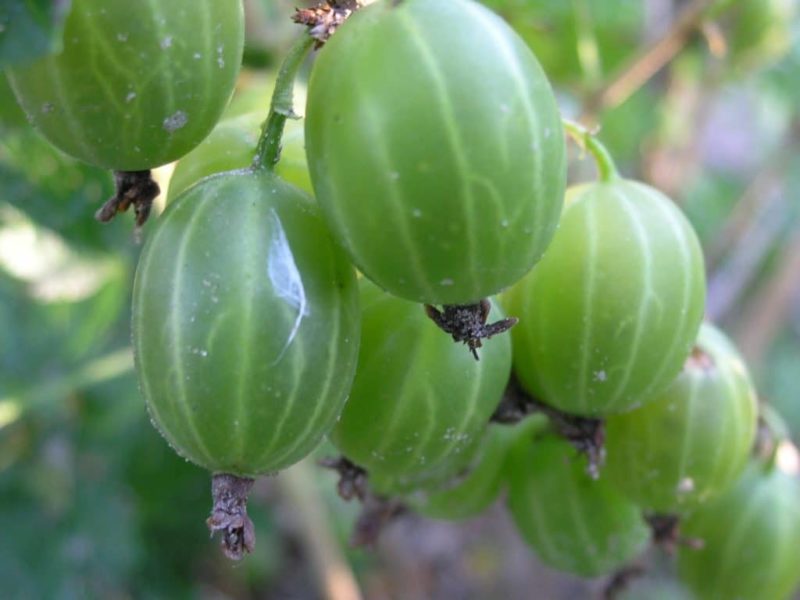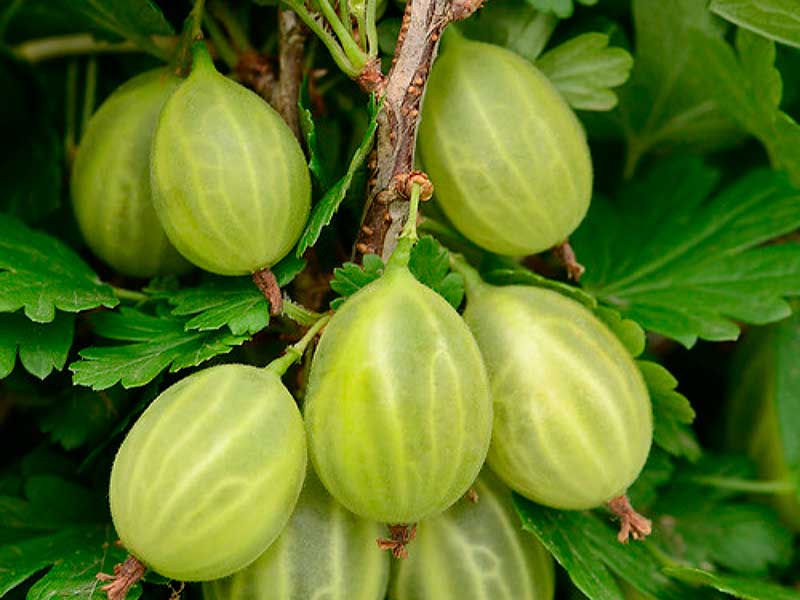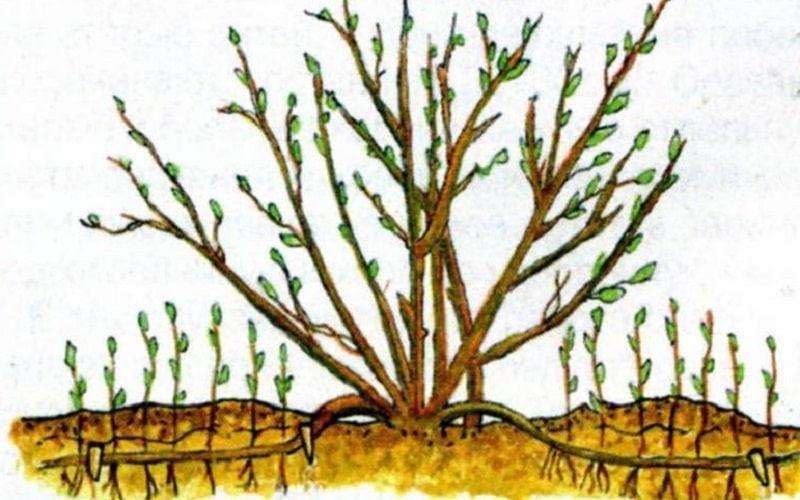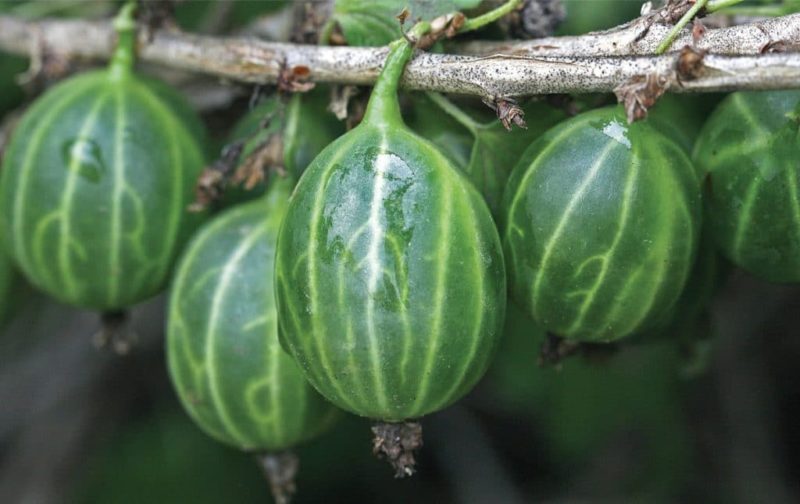One of the best domestic gooseberry varieties, Ural emerald
Gooseberry Ural emerald is an early variety intended for cultivation in the short Siberian summer, but it also feels good in the southern regions of Russia. The plant is characterized by abundant fruiting, unpretentiousness and high quality berries.
What kind of gooseberry is this?
Ural emerald is an early self-fertile gooseberry.
Description varieties:
- The bushes are compact, medium-sized, branched. They do not require much space on the site.
- Young shoots are green in color. Thorns, 7 to 9 mm long, are present along the entire length of the branches, so the berries are collected very carefully so as not to get hurt or damage clothing.
- The leaves are dark green, 5-lobed, have wrinkled teeth and wavy edges. There are large, medium and small leaves.
- The inflorescences are large, matte pink, self-pollinating.
- The berries are green, large and sweet. Stored for up to 5 days in a cool place. They tolerate transportation well over long distances.
- The culture is early ripening. Berries begin to be picked at the end of June. Young plants bear fruit for the first time in the 3rd year after planting.
The variety was bred by breeder V.S. Ilyin by crossing Perbornets Minusinsk and Samorodok. In 2000, the Ural emerald was included in the State Register.

Characteristics and description of bushes
This is an unpretentious plant that tolerates cold well and is resistant to pests and common diseases.
Temperature resistance
Gooseberries were bred by crossing frost-resistant varieties, so they tolerate frosts down to -35°C.If the cold is more severe, the plant is covered for the winter.
Moisture and drought resistance
The variety does not tolerate drought well. During the growing season it requires regular watering.
Important! Watering is stopped 10 days before harvesting. If this condition is not met, the berries will be sour.
Resistance to diseases and pests
The Ural emerald won the competition “The highest resistance to diseases and pests". Gooseberries are not susceptible to attack moths and pine sawfly, and is also not affected by powdery mildew.
Characteristics and description of fruits
The fruits are medium or large. Weight varies from 3.5 to 7 g. The shape of the berries is oval-round. They have very thin skin of emerald color.
The pulp is juicy with a small amount of seeds. Gooseberries taste sweet. Has a tasting rating of 5 out of 5.

Areas of use
This gooseberry is recommended to be consumed fresh, since after heat treatment the berries lose up to half of their beneficial substances. They are also used to make preserves and jams, but they have an inconspicuous gray-green color and a liquid consistency.
Advantages and disadvantages of the variety
The main advantages of the Ural emerald variety:
- High yield.
- Good frost resistance.
- Fruiting up to 20 years with proper care.
- The berries are large and tasty.
- Fruiting is abundant in almost all regions of Russia.
- High resistance to diseases.
- Easy to care for.
- Good transportability.
Flaws:
- The plant requires regular watering.
- The variety produces an unstable amount of berries.
Growing technology
Cultivation of the Ural emerald comes down to proper planting, regular watering, fertilizing and removing weeds from the site.If basic agrotechnical rules are observed, the bushes produce a plentiful and tasty harvest.
Optimal conditions
The variety cannot be planted on acidic and heavy soils. Also, the seedling will not grow if water stagnates in the area. It is advisable that the place be illuminated. In a shaded area, the bushes also bear fruit, but the quality of the harvest is significantly reduced.
Landing dates and rules
The seedling is planted in the fall, a month before the arrival of the first frost. This is required so that the roots have time to take root in the new place.
Landing is carried out as follows:
- 2 weeks before planting, prepare the planting hole. The diameter of the hole and depth are about 50 cm. The top layer of earth is thrown into a separate pile.
- After this, a nutrient substrate is prepared. The soil from the top layer is mixed with 2 buckets of humus, 250 g of superphosphate and 40 g of potassium sulfate, then poured onto the bottom of the hole, forming a hill.
- The roots of the seedling are evenly spread over this hill, after which they are sprinkled with a nutrient substrate. The earth is compacted. The planting hole is filled as much as possible.
- After planting, the seedling is watered. The tree trunk circle is mulched with humus or peat.
Further care
Water the plants weekly. 2-3 buckets of water are poured under each bush. After this, the soil is loosened so that a crust does not form in the tree trunk circle.
During the season, fertilizing is carried out 3 times:
- In the spring, before the start of the growing season, they are fed with rotted manure and nitrogen. This promotes the growth of green mass.
- The second time fertilizer is applied during flowering. During this period, they are fed with potassium-phosphorus fertilizers (50 g per bush).
- Potassium is added for the third time. One plant requires about 50 g.
For good fruiting, it is important to prune.The procedure begins when the bushes are 4-5 years old. The best time is considered to be early spring and late summer. All old branches are cut off, leaving only 10-15 shoots. Also remove 2-3 new branches so that the bushes do not thicken.
Possible problems, diseases, pests

The Ural emerald is resistant to major diseases, but is still sometimes affected by:
- Anthracnose. Appears as light glossy spots that gradually turn brown. With this disease, the leaves begin to dry out and fall off. For treatment, a solution of copper sulfate is used. Add 100 g of active substance to 1 bucket of water. The bushes are treated every 2 weeks for 2 months.
- Septoria. Brown spots appear on the berries and leaves, which gradually lead to curling and wilting of the foliage. To combat the disease, a Nitrafen solution is used. For the first time, the bushes are sprayed immediately after symptoms are detected. Repeated treatment is carried out after picking berries.
In some cases, the variety suffers from the following pests:
- Aphids. Small insects that lead to slow growth of gooseberries and leaf fall. Aphid usually found on the bottom of the leaf. Actellik helps a lot in pest control.
- Gooseberry sawfly caterpillars. One butterfly can lay up to 150 eggs, and in 1 season hatches 3 generations of caterpillars. To destroy them, use “Aktellik” or “Karbofos”.
Wintering
Before the arrival of winter, the bushes are prepared:
- All plant debris is removed from the site.
- They dig up the ground under the bushes.
- Perform sanitary pruning of gooseberries, removing all broken and diseased branches.
- The tree trunk circle is treated with a weak solution of potassium permanganate.
- 3 buckets of water are poured under each bush.
- The soil is mulched with peat or humus. The mulch layer should be at least 10 cm.
- With the arrival of winter, the plants are covered with snow.
Reproduction

Gooseberries are propagated in two ways:
- By cuttings. After flowering, annual shoots are cut and divided into cuttings 15-20 cm long. Then they are planted in a box with moist soil and covered with a bottle or jar to create a greenhouse. After the leaves appear, the cuttings are transplanted to a permanent place.
- By layering. A one-year or two-year-old shoot is pressed to the ground and buried. After some time it will have its roots. After this, the shoot is separated from the main bush.
Features of cultivation depending on the region
In the northern regions, the variety feels comfortable. The bushes are simply watered and fertilized regularly.
In the southern regions, more careful care is required in terms of watering. It is important to monitor the soil moisture level. If the top layer has dried out by 10 cm or more, the plants are watered.
Pollinator varieties
This is a self-pollinating gooseberry variety, so it does not require pollinating varieties.
Reviews from summer residents

Gardeners note the high taste of the berries and the unpretentiousness of the bushes.
Nikolay Petrovich, Veliky Novgorod: “I have been growing different varieties of gooseberries for many years. The Ural emerald is one of my favorites. Many people don't like gooseberries because they have a sour taste, but this variety is very sweet and juicy. It is pleasant to eat it fresh. It also makes good compotes, jams and liqueurs.”
Victor, Petrozavodsk: “This is a very tasty gooseberry, but it has too many thorns. Harvesting is difficult. But the berries are sweet and rich, and the bushes themselves are unpretentious. The main thing is to water on time".
Conclusion
Due to its frost resistance, the Ural emerald gooseberry is excellent for growing in areas with cold climates. Early ripening variety completely ripens towards the end of summer, giving a bountiful harvest of large, sweet, aromatic berries. The fruits are stored for a long time and tolerate transportation well.